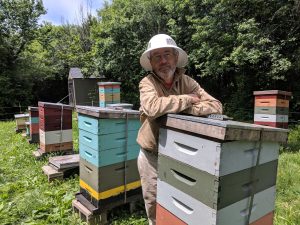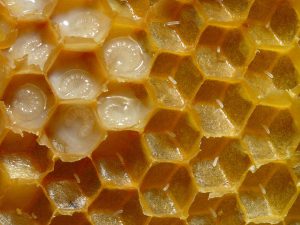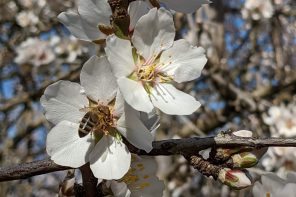Click Here if you listened. We’re trying to gauge interest so only one question is required; however, there is a spot for feedback!
Read along below!

Tropilaelaps
Part 2
By: Ross Conrad
Last month, we looked at the Tropilaelaps mite and its potential impact on North American beekeeping. While Tropilaelaps has yet to appear on the shores of North America, it can be found in the middle of a spat between the American Beekeeping Federation (ABF) and the Canadian Honey Council (CHC) over package imports.
A Warning Issued
On February 1, 2023, the ABF released a statement issuing a call for American beekeepers to encourage their congressional delegations to support the opening up of the Canadian border to honey bee package importation from the United States (Winter & Miller, 2023). The ABF letter notes that “the threat of the T mite (Tropilaelaps) being found in a southern hemisphere package and introduced to Canada is a real threat to all North American beekeepers.” The letter goes on to say, “This would be devastating to the North American beekeeping industry and production agriculture.” Furthermore, “ABF believes a new expedited risk analysis is needed” for both U.S. packages and those from other countries currently approved to export bees to Canada, in order to properly assess the current risk of a possible Tropilaelaps infestation.

Tropilaelaps’ need to access uncapped brood in order to feed every two days or so is the primary reason why it has not spread around the world so rapidly and extensively as the Varroa mite.
So far, Tropilaelaps has spread among South Asian countries including India, China, Pakistan, Myanmar (Burma), Thailand, Sri Lanka, Philippines, Afghanistan, S. Korea, Vietnam and Papua New Guinea. New Guinea and Australia are about 150 km (93 miles) apart at their closest shores: roughly the distance between Cuba and the U.S. mainland. The Canadian Food Inspection Agency (CFIA) currently allows the importation of honey bee packages into Canada from Australia, New Zealand, Chile, Ukraine and Italy. Queen imports into Canada are allowed from the same five countries as well as from the United States, Denmark and Malta. Given the close proximity of Canada’s Australian source of bees to a known Tropilaelaps infested country (New Guinea), the ABF is sounding the alarm concerning the risk of the mite making its way to Canada and then to the U.S.
Canada Weighs In
On February 22, 2023, the Canadian Honey Council responded to the ABF with their own statement (Scarlett, 2023). In it, the CHC called it “unfortunate that the American Beekeeping Federation, the American Honey Producers Association and those Canadian operators having an interest in importing American packaged bees are attempting to capitalize on the fear of introducing Tropilaelaps mites.”
The CHC goes on to say, “last year, Canadian beekeepers from most areas in the country experienced devastating losses and the demand for stock increased dramatically. Calls to open the border to U.S. packages intensified… The Canadian Food Inspection Agency put out an open call for additional research to see if there were any changes to the risks that had been identified in a 2013 risk assessment of U.S. packages.” The risks identified in 2013 were: Amitraz resistant mites, small hive beetle, American foulbrood resistance to antibiotics and Africanized bees. “The CHC has indicated that if the science supports the decision to open the border, the border should open,” the statement emphasized.
The CHC went on to note that since U.S. beekeepers can import bees from just two countries, Canada and New Zealand, and “New Zealand is just as close or closer to where Tropilaelaps is found…” they suggest that the U.S. could also import bees with the potential to harbor the mite. The CHC statement concludes by stating, “a North American concern is justified but it is far more likely that the mite will arrive by ocean liners than it is by packaged bees. The U.S. has 162 ocean freighters arriving every day and many of those are from China and Japan, two countries much more likely to have unwanted ‘visitors’ aboard. That is why calls in the USA for sentinel hives at ports have increased… This is not a trade issue, and it is always looked at as an animal health risk issue.”
| Year | # of Packages | Year | # of Packages |
|---|---|---|---|
| 2008 | 11,070 | 2016 | 44,997 |
| 2009 | 11,360 | 2017 | 27,387 |
| 2010 | 10,611 | 2018 | 31,638 |
| 2011 | 42,466 | 2019 | 41,339 |
| 2012 | 33,913 | 2020 | 13,746 |
| 2013 | 65,066 | 2021 | 8,661 |
| 2014 | 52,774 | 2022 | 56,737 |
| 2015 | 55,786 | 2023 | TBD |
Reality or Hype?
There is a high demand right now among Canadian beekeepers for packaged bees to replace heavy losses. Meanwhile for the first time in decades, almond production is contracting due to low almond prices and water issues aggravated by prolonged drought, and U.S. beekeepers are looking to replace some of this lost income. Opening up the Canadian border to U.S. package imports could help replace lost almond pollination fees.
American beekeepers certainly do not need another stressor on their bees, should Tropilaelaps make its way to America. However, as I pointed out last month, the T mite’s impact is not likely to be as devastating to the beekeeping industry as Varroa was in its initial years. Unlike the situation when the Varroa mite first arrived in North America, today we have approved mite treatments available for Varroa that are reported to also work on Tropilaelaps. We also know more about the biology of the T mite and its critical vulnerability of having to have constant access to its primary food source (uncapped brood) or they starve to death. These facts make the dire warnings spelled out in the ABF letter appear exaggerated.
Real World Impact
So how likely is a mite infestation into Canada from packages or caged queens really? Since no combs of brood are shipped within packages or queen cages, the chance that T mites will infiltrate North America through a bee shipment is slim. As numerous researchers have all pointed out, any mites that make it into the package or cage when it is initially populated with bees, are likely to be dead within two to three days at the most (Woyke, 1984 & 1987; Koeniger & Muzaffar, 1988; Rinderer et al., 1994). This is primarily why Varroa, which also originated in Asia, has spread to the four corners of the earth while Tropilaelaps is still largely confined to its native range.
There are a couple theoretical possibilities where mites could survive importation in packages and queens. If there are package producers or queen breeders that are super efficient and ship orders out the same day that they are packaged or caged, it is possible that the receiving beekeeper will install their shipment into a hive the same day that it arrives via overnight airfreight. Thus, any mites that happen to be riding along in a package or cage would only be without food for a day or so and could survive the trip. To protect American beekeepers, a simple requirement that bee shipments must be held for a minimum of 48 hours before they are introduced into hives containing uncapped brood, would help ensure no Tropilaelaps mites that hitched a ride along with the bees are able to survive the journey. This would mostly affect queen imports since packages are usually installed into hives with foundation or empty frames of drawn comb, or perhaps combs containing some honey and/or pollen. It is rare that packages get installed into hives in which uncapped brood is already present.
The other possibility is that there are occasional reports in the literature of Tropilaelaps being observed sitting at the base of an adult honey bee’s wings. This is significant since the base of the wings is one of the few locations where the hard exoskeleton of the bee is soft enough for the Tropilaelaps mite to be able to pierce it with their mouth parts and feed on hemolymph (Khongphinitbunjong et al., 2012). Thus, it appears that sometimes a T mite figures out that it can feed on an adult bee.
While it is certainly a possibility that Canada will become a Tropilaelaps host country and spread the mite to America, the availability of approved Varroa mite treatments that are also reported to work on Tropilaelaps means that should such an infestation take place, is unlikely to cause a major catastrophe for American beekeepers.
The Scofflaw Factor
Unfortunately, we beekeepers are notorious scofflaws. This tendency exposed itself clearly after Varroa arrived and many beekeepers turned to off-label (illegal) uses of pesticides to control the mites. Since there are likely to be some beekeepers that cannot be trusted to honor a 48 hour delay before installing bees into hives that contain uncapped brood, Canadian bee breeders that supply the U.S. could also be required to wait 48 hours after packaging or caging bees before shipment. This way if one person in the supply chain “bends the rules” the other acts as a backup to ensure the mites are unlikely to survive. Of course, the extensive border between our two countries would almost guarantee that should Tropilaelaps make its way to Canada and spread throughout the country, at some point natural swarms will carry the mite across the border into the United States. However, unless a Canadian swarm usurps a U.S. colony and replaces the mother queen with their usurping queen (a highly unlikely situation), natural swarms are not expected to cause Tropilaelaps to spread across the border. The extended broodless period when a swarm emerges from a hive and when it begins raise new brood in a new location also prevents swarm castaways on an ocean liner from carrying the mite far.
There is always the possibility however that the mite could be smuggled in illegally. Some people claim that back in the 1980s, Argentina was getting bees from Asia, breeding queens, smuggling them into Florida under the radar and ended up bringing the Varroa mite to the U.S. Folks worry that something similar might happen should Australia end up getting the mite, and export the mite to Canada. Please note, all this is still theoretical. As far as anyone knows, while Varroa has recently arrived in Australia, Tropilaelaps has not yet made its way to the island continent.
You Catch More Bees with Honey Than You do With Vinegar
Rather than point fingers at our Canadian neighbors and make them out to be the “bad guy”, U.S. beekeepers would do better to focus on the positive impacts Canadians can expect should they open up their border to U.S. honey bee packages. The main one that comes to mind is an improved environmental footprint.
The American beekeeping industry is very fossil fuel intensive. Regularly transporting bees throughout the country on 18-wheeled, diesel powered trucks and shipping bees overnight by airfreight creates a lot of green-house gas emissions. Dramatically reducing the distance that packages must travel by air, will greatly help the beekeeping industry start to address the festering issue of heavy fossil-fuel reliance that has mostly been ignored to date. This means doing exactly what the ABF recommends, localizing and regionalizing industry so we no longer are relying on extensively long supply chains. The global COVID pandemic exposed the serious drawback of relying on products and supplies that have to be shipped from overseas and the global climate crisis is exposing another. Relocalizing as much of society as possible will be required if we are to successfully reduce energy use and GHG emissions, prevent global ecological collapse, save our bees and maintain organized human existence. An additional benefit is that reduced shipping distances should result in lower overall costs, allowing U.S. bee producers to compete competitively with bees from down under while allowing Canadian beekeepers to enjoy lower prices.
I get the ABF’s concerns. Declining almond prices and a lack of available water from increasing droughts out west is causing many almond producers to pull their older trees from production. For the first time in well over a decade, almond growers will be requiring fewer hives for pollination, not more. For those beekeepers that fell into the economic trap of relying on almond pollination fees for a large percentage of their annual income, the severe economic hit they are going to receive will be challenging. The greater the share of their annual income from almond pollination, the more difficult it will be for the beekeeper to stay afloat. Opening up a new market in Canada for U.S. packaged bees, while certainly not enough to entirely replace the lost almond pollination income, will help take some of the sting out of the loss. Efforts to use the fear of Tropilaelaps to facilitate such a trade agreement is a weak approach.
Ross Conrad is the author or Natural Beekeeping: Organic approaches to modern apiculture and the Land of Milk and Honey: A history of beekeeping in Vermont. Ross will be teaching a beginner organic beekeeping class the weekend of May 20-21 and an intermediate class June 4th in Vermont. For more information visit: www.dancingbeegardens.com
References:
Khongphinitbunjong, K., de Guzman, L.I., Burgett, M.D., Rinderer, T.E., Chantawannakul, P. (2012) Behavioral responses underpinning resistance and susceptibility of honey bees to Tropilaelaps mercedesae. Apidologie 43: 590–599 https://doi.org/10.1007/s13592-012-0129-x
Koeniger, N., and Muzaffar, N. J. J. O. A. R. (1988) Lifespan of the parasitic honeybee mite, Tropilaelaps clareae, on Apis cerana, dorsata and mellifera. Journal of Apicultural Research 27(4): 207-212.
Rinderer, T.E., Oldroyd, B.P., Lekprayoon, C., Wongsiri, S., Boonthai, C.,Thapa, R. (1994) Extended survival of the parasitic honey bee mite Tropilaelaps clareae on adult workers of Apis mellifera and Apis dorsata, Journal of Apicultural Research, 33(3):171-174, DOI:10.1080/00218839.1994.11100866
Scarlett, Rod (2023) Canadian Honey Council letter, https://honeycouncil.ca/
Winter, Dan & Jay Miller, (2023) American Beekeeping Federation letter, https://www.beeculture.com/abf-statement/
Woyke, J. (1984) Survival and prophylactic control of Tropilaelaps clareae infesting Apis mellifera colonies in Afghanistan, Apidologie, 15(4):421-434
Woyke, J. (1987) Length of Stay of the Parasitic Mite Tropilaelaps Clareae Outside Sealed Honey Bee Brood Cells as a Basis for its Effective Control, Journal of Apicultural Research, 26(2):104-109, DOI:10.1080/00218839.1987.11100745








